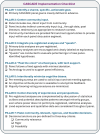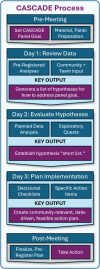CASCADE: a community-engaged action model for generating rapid, patient-engaged decisions in clinical research
- PMID: 40597746
- PMCID: PMC12211934
- DOI: 10.1186/s12874-025-02565-7
CASCADE: a community-engaged action model for generating rapid, patient-engaged decisions in clinical research
Abstract
Background: Integrating patient and community input is essential to the relevance and impact of patient-focused research. However, specific techniques for generating patient and community-informed research decisions remain limited. This manuscript describes a novel CASCADE method (Community-Engaged Approach for Scientific Collaborations and Decisions) that was developed and implemented to make actionable, patient-centered research decisions during a federally funded clinical trial.
Methods: The CASCADE method was developed to facilitate decision-making, combining techniques from a variety of past methodologies with new approaches that aligned with project constraints and goals. The final result was a series of procedures that spanned seven thematic pillars (1) identifying a shared, specific, and actionable goal; (2) centering community input; (3) integrating both pre-registered statistical analyses and exploratory "quests"; (4) fixed-pace scheduling, supported by technology; (5) minimizing opportunities for cognitive biases typical to group decision making; (6) centering diversity experiences and perspectives, including those of individual patients; (7) making decisions that are community-relevant, rigorous, and feasible. The final approach was piloted within an active clinical trial, with the primary goal of describing feasibility (participation, discussion topics, timing, quantity of outputs).
Results: The inaugural CASCADE panel aimed to identify ways to improve an algorithm for matching patients to specific types of telehealth programs within an active, federally funded clinical trial. The panel was attended by 27 participants, including 5 community interest-holders. Data reviewed to generate hypotheses and make decisions included (1) pre-registered statistical analyses, (2) results of 12 "quests" that were launched during the panel to answer specific panelist questions via exploratory analyses or literature review, (3) qualitative and quantitative patient input, and (4) team member input, including by staff who represented the focal patient population for the clinical trial. CASCADE pillars were successfully integrated to generate 18 initial and 6 final hypotheses, which were translated to 19 decisional changes.
Conclusions: The CASCADE approach was an effective tool for rapidly, efficiently making patient-centered decisions during an ongoing, federally funded clinical trial. Opportunities for further development will include exploring best-practice structural procedures, enhancing greater opportunities for pre-panel input by community interest-holders, and determining how to best standardize CASCADE outputs.
Trial registration: The CASCADE procedure was developed in the context of NCT05999448.
Keywords: CASCADE; Clinical trials; Community-based participatory research; Decision making; Delphi panel; Patient acceptability; Patient engagement; Project wellcast.
© 2025. The Author(s).
Conflict of interest statement
Declarations. Ethics approval and consent to participate: No human subjects research is directly reported in this manuscript. The broader human subjects protocol for the affiliated project, Project WellCAST, was approved by Purdue University IRB #2022 − 1580. All participants provided informed consent. Consent for publication: Not applicable. Competing interests: The authors declare no competing interests.
Figures
Update of
-
CASCADE: A Community-Engaged Action Model for Generating Rapid, Patient-Engaged Decisions in Clinical Research.Res Sq [Preprint]. 2024 Aug 27:rs.3.rs-4790564. doi: 10.21203/rs.3.rs-4790564/v1. Res Sq. 2024. Update in: BMC Med Res Methodol. 2025 Jul 1;25(1):168. doi: 10.1186/s12874-025-02565-7. PMID: 39257986 Free PMC article. Updated. Preprint.
Similar articles
-
CASCADE: A Community-Engaged Action Model for Generating Rapid, Patient-Engaged Decisions in Clinical Research.Res Sq [Preprint]. 2024 Aug 27:rs.3.rs-4790564. doi: 10.21203/rs.3.rs-4790564/v1. Res Sq. 2024. Update in: BMC Med Res Methodol. 2025 Jul 1;25(1):168. doi: 10.1186/s12874-025-02565-7. PMID: 39257986 Free PMC article. Updated. Preprint.
-
Health professionals' experience of teamwork education in acute hospital settings: a systematic review of qualitative literature.JBI Database System Rev Implement Rep. 2016 Apr;14(4):96-137. doi: 10.11124/JBISRIR-2016-1843. JBI Database System Rev Implement Rep. 2016. PMID: 27532314
-
Can We Enhance Shared Decision-making for Periacetabular Osteotomy Surgery? A Qualitative Study of Patient Experiences.Clin Orthop Relat Res. 2025 Jan 1;483(1):120-136. doi: 10.1097/CORR.0000000000003198. Epub 2024 Jul 23. Clin Orthop Relat Res. 2025. PMID: 39051876
-
Eliciting adverse effects data from participants in clinical trials.Cochrane Database Syst Rev. 2018 Jan 16;1(1):MR000039. doi: 10.1002/14651858.MR000039.pub2. Cochrane Database Syst Rev. 2018. PMID: 29372930 Free PMC article.
-
Consumers' and health providers' views and perceptions of partnering to improve health services design, delivery and evaluation: a co-produced qualitative evidence synthesis.Cochrane Database Syst Rev. 2023 Mar 14;3(3):CD013274. doi: 10.1002/14651858.CD013274.pub2. Cochrane Database Syst Rev. 2023. PMID: 36917094 Free PMC article.
Cited by
-
Optimizing a Personalized Health Approach for Virtually Treating High-Risk Caregivers of Children With Neurogenetic Conditions (Project WellCAST): Protocol for a Randomized Controlled Trial.JMIR Res Protoc. 2025 Jun 25;14:e64360. doi: 10.2196/64360. JMIR Res Protoc. 2025. PMID: 40560646 Free PMC article.
References
-
- Harrington RL, Hanna ML, Oehrlein EM, Camp R, Wheeler R, Cooblall C, et al. Defining patient engagement in research: results of a systematic review and analysis: report of the ISPOR patient-Centered special interest group. Value Health. 2020;23(6):677–88. - PubMed
-
- Graham KL, Green S, Kurlan R, Pelosi JS. A Patient-Led Educational Program on Tourette Syndrome: Impact and Implications for Patient-Centered Medical Education. Teach Learn Med. 2014;26(1):34–9. Available from: 10.1080/10401334.2013.857339 - PubMed
MeSH terms
Associated data
Grants and funding
LinkOut - more resources
Full Text Sources
Medical
Miscellaneous





